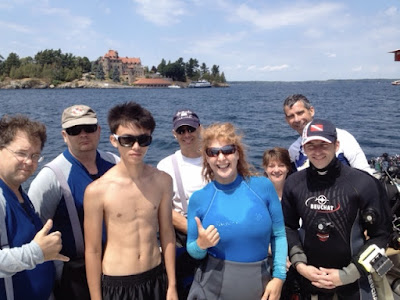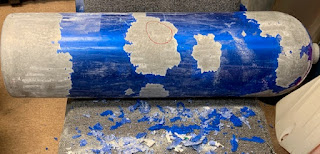I'm Thankful for...Drysuits!
 |
| Drysuit divers on a trip to the Saint Lawrence Seaway L-R: Bill Belcher, Bob and Lance Bennett, Fred Stratton and Canadian divers from Quebec Photo: Rose Bennett |
Instructor and Repair Technician
fred@bubblesornot.com
I earned my PADI Open Water Diver certification in 1987 in beautiful Batangas, Republic of the Philippines. The water temperature was in the mid-80s, requiring no exposure protection. My next dives were in Thailand, again, bath-water warm. Ahhh...
 |
| Author in custom two-piece 7mm wetsuit diving in Monterey Bay California, 1989 Photo: Colleen |
 |
| Father and daughter in light wetsuits appropriate for Hawaii Photo: Emy Stratton |
Then I received orders to Japan where the water temperature swung from the mid-70s to low 50s. I bought my first drysuit and, oh yeah, I was warm and dry throughout the dive.
That first dry suit was a trilaminate. A few years later I bought a Pinnacle Black Ice crushed neoprene suit shortly after I earned my Cave Rebreather certification as four-hour dives were possible. I also have a DUI 30/30, a Pinnacle Evolution and a Dive Rite 905. Each has its pros and cons.
Drysuit Material
 |
| Altitude dive at 6,100' in Aurora, Colorado in Pinnacle Black Ice compressed neoprene drysuit Photo: Fred Stratton |
Compressed or Crushed Neoprene: Compressing or crushing neoprene reduces its buoyancy and increases its resistance to cuts and abrasions. Neoprene drysuits almost feel like a wetsuit in that they conform to one's body. They are heavier than other suits and they can be pricey, although the per-dive cost can be lower due do their longevity.
A good compressed neoprene suit is the Black Ice from Pinnacle Aquatics. DUI uses a unique process to crush their neoprene which removes all bubbles, reducing buoyancy and increasing durability. DUI's CF200X 3mm crushed neoprene drysuit is made in San Diego, USA, as are all DUI drysuits.
 |
| Scubapro's Everdry 4 Pro neoprene drysuit Photo: Scubapro |
Neoprene: The advantages of a neoprene drysuit include comfort, price and insulating qualities. Its disadvantages include buoyancy, slow drying, and loss of insulation at depth.
Scubapro's Everdry 4 Pro uses 4mm of dense neoprene that resists compression to a degree. The Everdry is form-fitting which makes it streamlined in the water. Shoulder and knee pads resist abrasion, extending suit longevity.
 |
| Custom made DUI TLS350 trilaminate suit shown with Zip Seals and thigh pockets Photo: DUI |
Trilaminate: This suit is comprised of three layers, usually two layers of tough polyester or nylon sandwiching a layer of butyl rubber. "Trilam" suits dry quickly and are easy do don and doff. They are light and pack easily for travel. They are relatively thin so trilam divers usually accumulate an array of layerable undergarments. Good trilam suits include the DUI Yukon II and the TLS350 (used by military divers) and Dive Rite's 905 EXP made from six-ply butyl rubber sandwiched between rugged polyester.
Vulcanized Rubber: Popular with commercial and public safety divers, vulcanized rubber suits are made from synthetic and natural rubber. They dry quickly and resist abrasion and punctures. Divers choosing these suits value their toughness and reliability while working in demanding environments.
Composite: These suits can be crushed neoprene below the waist, providing abrasion resistance in critical areas like the buttocks and knees, and trilaminate on top.
Off-the-Rack or Tailor Made?
Have you ever paid a tailor to measure and make a suit or dress just for you? If so, you can appreciate the difference between generic drysuit sized and a bespoke suit that conforms to your body in all the right places.
You can save money if an off-the-rack drysuit fits you well. However, if you are in between sizes and don't want to compromise on fit and comfort, invest in a DUI Signature Series custom suit. Tara is trained in DUI's Made to Measure process. She takes 20 separate measurements, from your neck to your ankles, which DUI's skilled craftspeople turn into the drysuit of your dreams. (Some divers report using their DUI drysuits for over 20 years! That's a pretty good return on your investment!)
Equipment Considerations
A drysuit is like a BC in that it has a means to add low pressure (LP) air on descent and release expanding air on ascent. The LP air hose attaches to the inflator valve on the diver's chest. The drysuit exhaust valve is usually on the left upper arm, the idea being that as a diver release expanding air from her BC, so too will the drysuit exhaust valve purge excess air from the drysuit.
 |
| Fred Stratton and Bill Belcher wreck diving in Canada in trilam drysuits. Photo: Bob Bennett |
Divers can make some drysuit repairs, even in the field (quick-drying trilam suits). Other repairs, such as zipper replacement, must be performed by skilled professionals.
Some drysuit divers utilize small cylinders (6, 8 or 13cf) filled with the inert gas argon to inflate their drysuit. Argon is denser than air which some divers credit as having higher insulation quality. These cylinder are clearly marked ARGON - Do Not Breathe.
Are you hydrated?
 |
| P valve greatly increases personal comfort while facilitating thorough hydration Photo: Dive Rite |
Tell the truth. Have you ever reduced your fluid intake before a dive because you didn't want to urinate in your exposure suit? We know we should hydrate because it's good for general health and medically indicated to reduce the risk of decompression sickness (DCS). Hydration is always important and even more if you are on the BoN April 2019 dive trip to Curacao or conducting long technical dives.
The solution is a pee valve, a one-way valve placed on the suit's inner thigh with a tube that connects to...well, you get the idea. Yes, they make them for women, too. So add a P valve to your suit and hydrate!
Weighting for Drysuit Diving
Weighting is challenging for new drysuit divers. Invest time in a pool getting your trim and buoyancy right before diving dry in open water. Remember the factors you've added are (1) different exposure suit material (2) a suit that you can inflate and deflate like a BC (3) air shifting inside your drysuit as you change your trim in the water column.Your Drysuit Course instructor will have you purposefully get legs up (allowing air in your drysuit legs) in order to right yourself, all in the safety of a pool. He will also walk you through these options for adjusting your trim and buoyancy.
- Gaiters wrap around your lower legs and take away space where air could accumulate.
- Ankle weights of 1, 2 or 3 pounds can help offset that awkward legs up position.
- Utilize the trim pockets that your BC likely has. It's amazing what a few strategically placed pounds can do to help you achieve a beautiful horizontal swimming position.
- Log your pool session in your logbook. Note what weighting technique worked best.
- Now try your drysuit in a shallow part of an open water setting. The lakes here in Georgia (Clarks Hill) and South Carolina (Jocassee) are ideal. Venture into deeper water once you gain confidence in your trim and buoyancy.
Seals
| DUI's innovative Zip Seals enable rapid swap of torn seals in the field Photo: DUI |
DUI pioneered diver-replacable seals with their Zip Seals. They work like the seal on a ZipLoc baggie. Should you tear a seal you can replace it yourself. It could mean the difference between a two-minute delay to swap out seals versus cancelling your dive because your drysuit has become a wetsuit.
Maintenance
 |
| The ingenious HangAir powered fan exposure suit hanger. Photo: Underwater Kinetics |
If you get water inside your suit, rinse with fresh water and hang it upside down to dry. A cool option is Underwater Kinetics' HangAir, a broad-shouldered drysuit hanger with a built-in fan which accelerates drying.
Wax your zipper regularly. Pulling on a stiff zipper prematurely wears out the fabric along the zipper. A broken drysuit zipper is nearly impossible to fix in the field.
Use talc to preserve your seals, be they latex or silicone, and store your suit in a cool, dry, dark place. Prolonged exposure to UV light will turn your seals into thick, black jelly.
Summary
- Diving dry lets you enjoy year-round diving.
- Drysuits can last a decade or more with proper care.
- Drysuits make multi-hour technical dives possible.
- Invest in a P valve then hydrate all you want.
- A PADI Dry Suit Diver course will help accelerate your mastery of diving dry.
- Diving dry reduces your risk of hypothermia, a potent DCS risk factor.
- Lastly, I ask you: wet and cold or warm and dry?
Coming in December



Excellent article! Who knew you could install a Pee valve in your suit! Hydration is key, so glad you pointed it out as it is likely often overlooked...
ReplyDelete